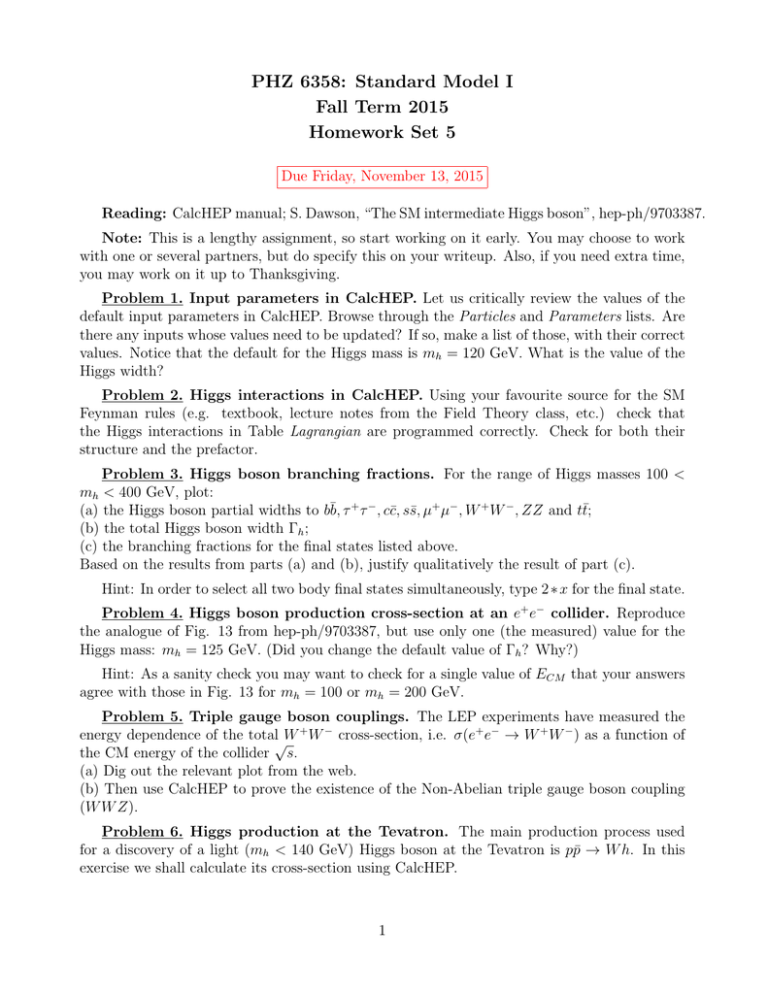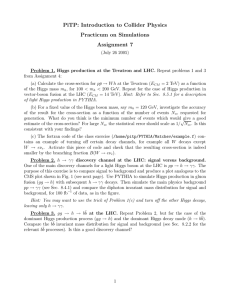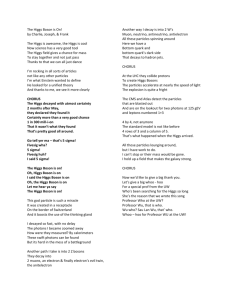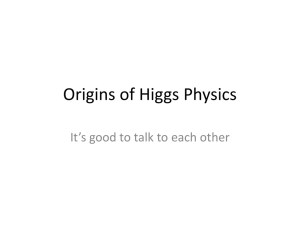PHZ 6358: Standard Model I Fall Term 2015 Homework Set 5
advertisement

PHZ 6358: Standard Model I Fall Term 2015 Homework Set 5 Due Friday, November 13, 2015 Reading: CalcHEP manual; S. Dawson, “The SM intermediate Higgs boson”, hep-ph/9703387. Note: This is a lengthy assignment, so start working on it early. You may choose to work with one or several partners, but do specify this on your writeup. Also, if you need extra time, you may work on it up to Thanksgiving. Problem 1. Input parameters in CalcHEP. Let us critically review the values of the default input parameters in CalcHEP. Browse through the Particles and Parameters lists. Are there any inputs whose values need to be updated? If so, make a list of those, with their correct values. Notice that the default for the Higgs mass is mh = 120 GeV. What is the value of the Higgs width? Problem 2. Higgs interactions in CalcHEP. Using your favourite source for the SM Feynman rules (e.g. textbook, lecture notes from the Field Theory class, etc.) check that the Higgs interactions in Table Lagrangian are programmed correctly. Check for both their structure and the prefactor. Problem 3. Higgs boson branching fractions. For the range of Higgs masses 100 < mh < 400 GeV, plot: (a) the Higgs boson partial widths to bb̄, τ + τ − , cc̄, ss̄, µ+ µ− , W + W − , ZZ and tt̄; (b) the total Higgs boson width Γh ; (c) the branching fractions for the final states listed above. Based on the results from parts (a) and (b), justify qualitatively the result of part (c). Hint: In order to select all two body final states simultaneously, type 2 ∗ x for the final state. Problem 4. Higgs boson production cross-section at an e+ e− collider. Reproduce the analogue of Fig. 13 from hep-ph/9703387, but use only one (the measured) value for the Higgs mass: mh = 125 GeV. (Did you change the default value of Γh ? Why?) Hint: As a sanity check you may want to check for a single value of ECM that your answers agree with those in Fig. 13 for mh = 100 or mh = 200 GeV. Problem 5. Triple gauge boson couplings. The LEP experiments have measured the energy dependence of the total√W + W − cross-section, i.e. σ(e+ e− → W + W − ) as a function of the CM energy of the collider s. (a) Dig out the relevant plot from the web. (b) Then use CalcHEP to prove the existence of the Non-Abelian triple gauge boson coupling (W W Z). Problem 6. Higgs production at the Tevatron. The main production process used for a discovery of a light (mh < 140 GeV) Higgs boson at the Tevatron is pp̄ → W h. In this exercise we shall calculate its cross-section using CalcHEP. 1 (a) Start up CalcHEP and generate the diagrams for pp̄ → W + h and pp̄ → W − h. Without doing any calculations, try to guess and rank the first few dominant subprocesses according to their importance. (b) Calculate the cross-section for pp̄ → W ± h at the Tevatron (ECM = 2 TeV) as a function of the Higgs mass mh , for 100 < mh < 200 GeV. Hint: The cross-section is a slowly varying function of mh , so you will only need to compute it at 3-4 points. (c) Check your guesses from (a) against the numerical results from (b). Problem 7. Higgs production at the Tevatron: signal versus background. For a Higgs discovery in pp̄ → W h at the Tevatron, one makes use of the decays W → `ν and h → bb̄. The final state signature is therefore `νbb̄. The main background is W bb̄ production, where the b’s were produced through a gluon, photon or a Z. On the same plot, show the bb̄ invariant mass distribution Mbb̄ for the W h signal and the W bb̄ background. Notice that because of the very small Higgs width Γh , the signal will peak very sharply at Mbb̄ = mh . In reality, however, the energy of the b-jets is not perfectly measured, which results in an uncertainty in Mbb̄ of order 10%. An easy way to account for the poor mass resolution and thus make our plot more “realistic”, is to simply inflate the Higgs width Γh to 0.1mh ∼ 12 GeV. Hint: You may need to use the option “regularization” to constrain Mbb̄ near the s-channel gluon, photon, Z or H resonances. Problem 8. Playing with CalcHEP. [Optional, recommended for HE theorists] Use the analytical tools in CalcHEP to verify some of the results from Chapter 5 of Peskin&Schroeder. Try to make as many cross-checks of the final answers as you can think of. Consider (a) e− µ− → e− µ− . (b) Compton scattering. (c) Pair annihilation. (d) Bhabha scattering. Hint: Be careful to regulate the cross-section by using a cut on the forward angle θ. (e) e+ e− → γ + B from problem 5.5. 2




